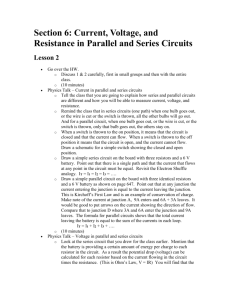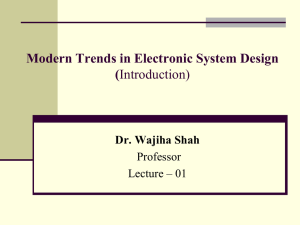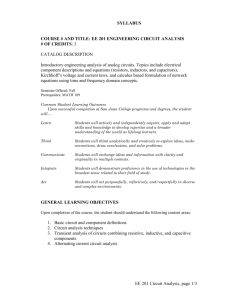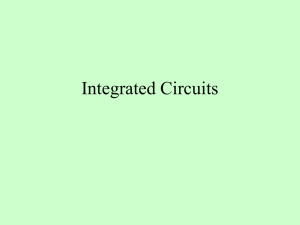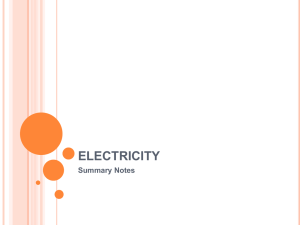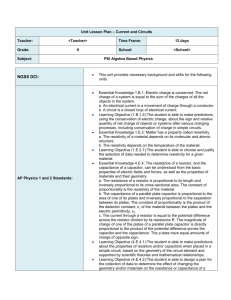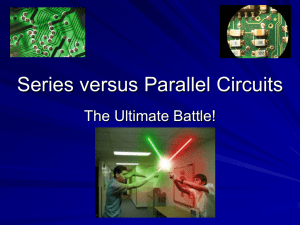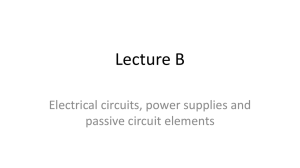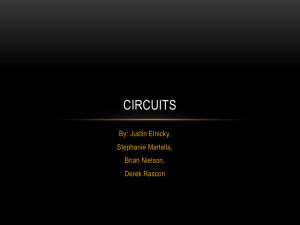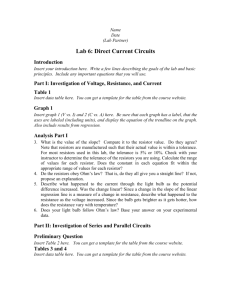Lecture 0: Overview of Class
advertisement
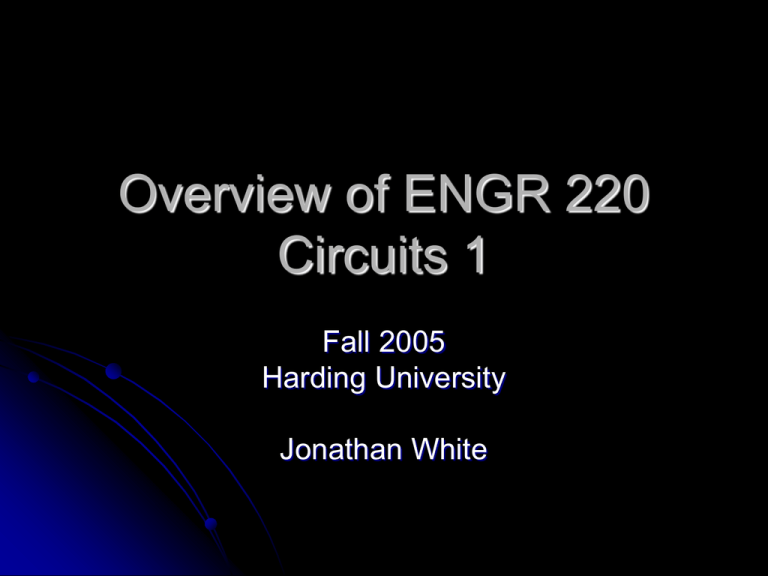
Overview of ENGR 220 Circuits 1 Fall 2005 Harding University Jonathan White Sections Basic Concepts Resistive Circuits Capacitors/Inductors RC, RL, and RLC circuits OP Amps Intro. to AC Circuits Basic Concepts Charge – electrical property of matter that exists because of an excess or deficiency of electrons Current – rate of flow of charge (electrons) Voltage – amount of energy available to move electrons from one point to another in a circuit Energy – fundamental capacity to do work Power – rate of energy usage Electron shells / Valence electrons / Conductors/Semiconductors/Insulators / Circuit symbols Basic Concept Questions How many coulombs of charge do 50 x 1031 electrons possess? 500 joules of energy are used to move 100 C of charge through a resistor. What’s the voltage across the resistor? How much energy does a 12 V battery in your car use to move 2.5 C through the electrical circuit? .6 C passes a point in 3 s. What’s the current in amperes? Resistive Circuits – Basic Laws Resistor – Device that opposes the flow of current Ohm’s Law: v = iR Kirchoff’s voltage law: Sum of voltages around a closed loop is zero Kirchoff’s current law: Sum of currents entering a node is equal to the currents leaving a node Parallel resistors: Req = (R1R2) / (R1 + R2) Series resistors: Req = (R1 + R2) Power: P = I2R, P = VI, P = V / I Basic Law Questions In the circuit below, what’s V1 and V2 ? Resistive Circuits - Analysis Nodal Analysis - Choose a node; setup current and voltage equations using KCL and Ohm’s Law; solve for unknown voltages Mesh Analysis – Find all loops; setup variables as the unknown mesh currents; apply KVL to each loop; solve for the unknown voltages. Resistive Circuits – Analysis Questions Using mesh current analysis, determine the current through RL if Vsource = 5V, R1=R2=10 KΩ, R3=R4=5 KΩ, R5=RL=2 KΩ ? Resistive Circuits – Other topics Superposition – Method of analyzing circuits with 2 or more independent sources by examining effects of each source by itself and then combing the effects. Thevenin’s Theorem: A 2 terminal circuit can be reduced to a voltage source in series with an equivalent resistance. Norton’s Theorem: A 2 terminal circuit can be reduced to a current source in parallel with an equivalent resistance. Resistive Circuits – Other Topics Questions Find the Thevenin equivalent with respect to the 3K resistor. Capacitors Capacitor – Device that stores charge. Physically, 2 conductive plates that are very close to each other but not touching Capacitance: C = Q / V Current through a capacitor: I = C (dv / dt) Series capacitors: Ceq = (C1C2) / (C1 + C2) Parallel capacitors : Ceq = (C1 + C2) Just the opposite of resistors Acts like an open circuit to dc. Inductors Device that stores energy in its magnetic field. Resists changes in current by inducing a voltage to oppose the change in current. Physically: Coil of wire wrapped around a conductive material. Voltage through an inductor: v = L (di / dt) Series and Parallel Inductors: Like resistors. Acts like a short circuit to dc. Capacitor/Inductor Questions What’s the equivalent capacitance of the circuit below? Combinations of Resistors, Inductors, and Capacitors What is the step response of the circuit below? OP Amps Takes an input and produces a desired output. OP Amp – Can be designed to perform mathematical operations such as addition, subtraction, multiplication, division, differentiation, and integration. Basis for analog computers OP Amp Questions What is Vo equal to in the circuit below? AC Circuits Introduction Sine waves, frequency, period RMS values of voltage Angular measurement of sine waves Equation for sine waves Non sinusoidal waveforms

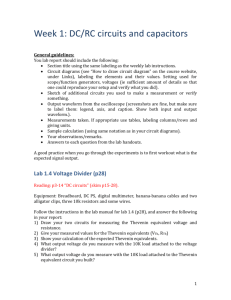
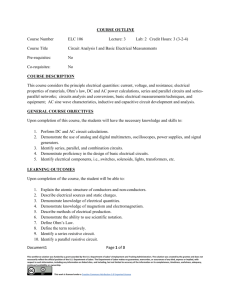


![ECE233b-introduction.ppt [Read-Only]](http://s3.studylib.net/store/data/008839285_1-a5bb065a48987442ea5e7017b3a1c08c-300x300.png)

